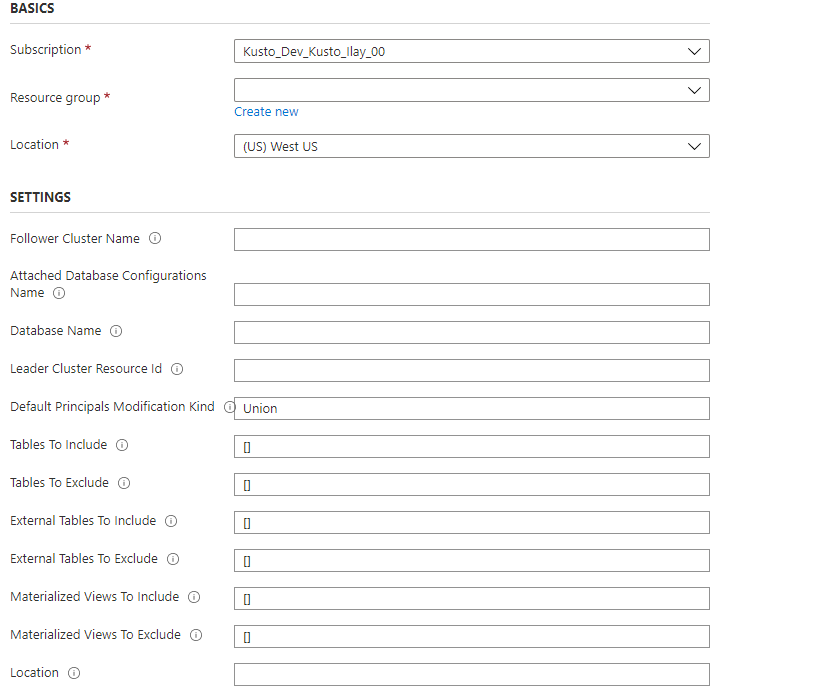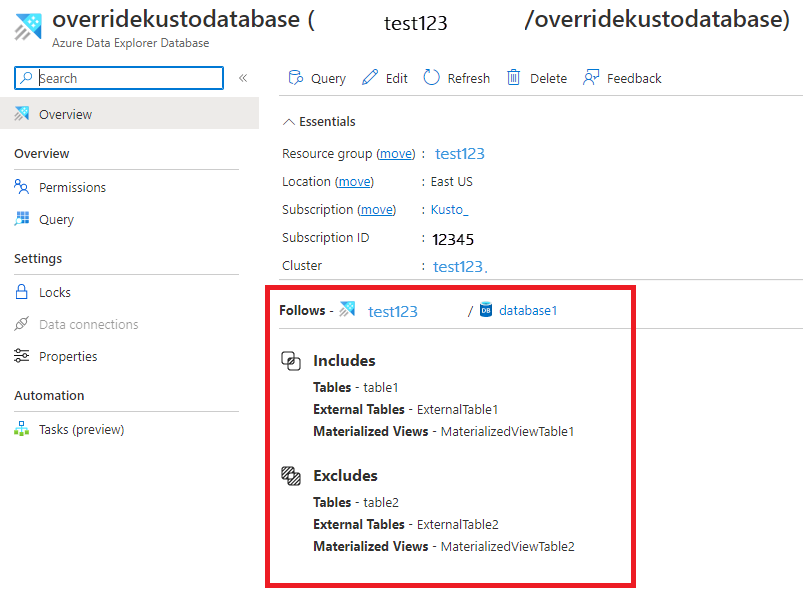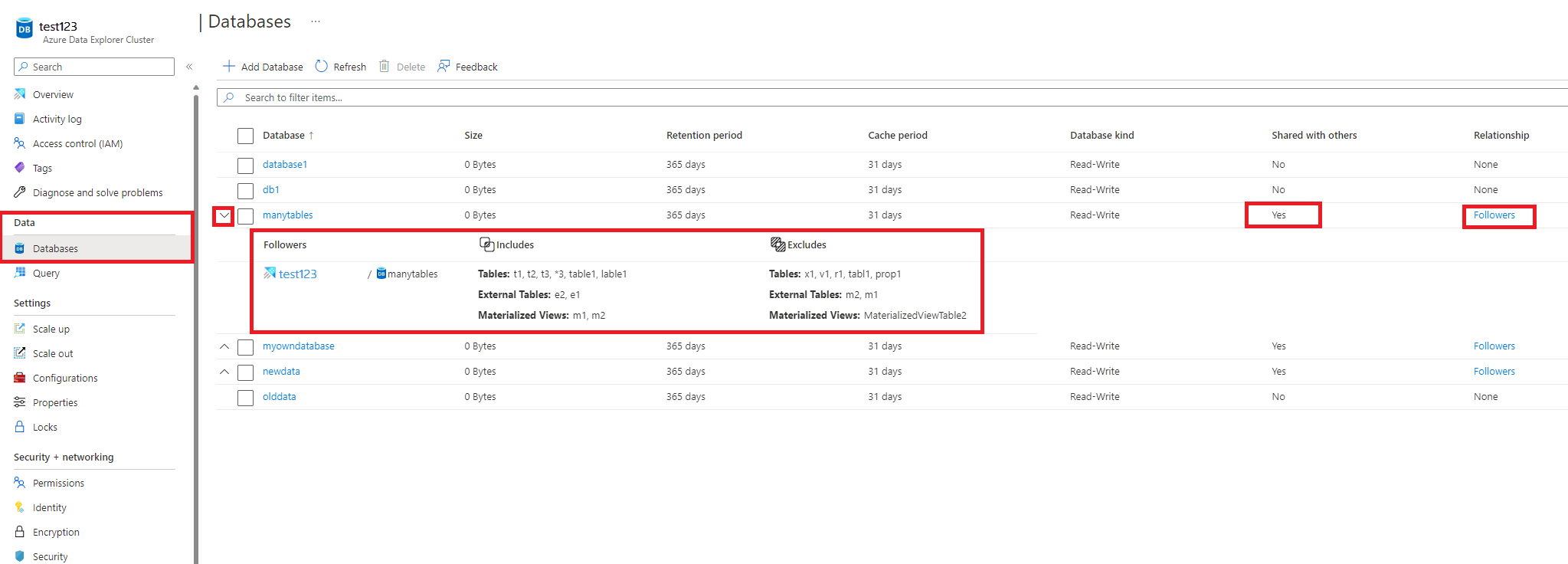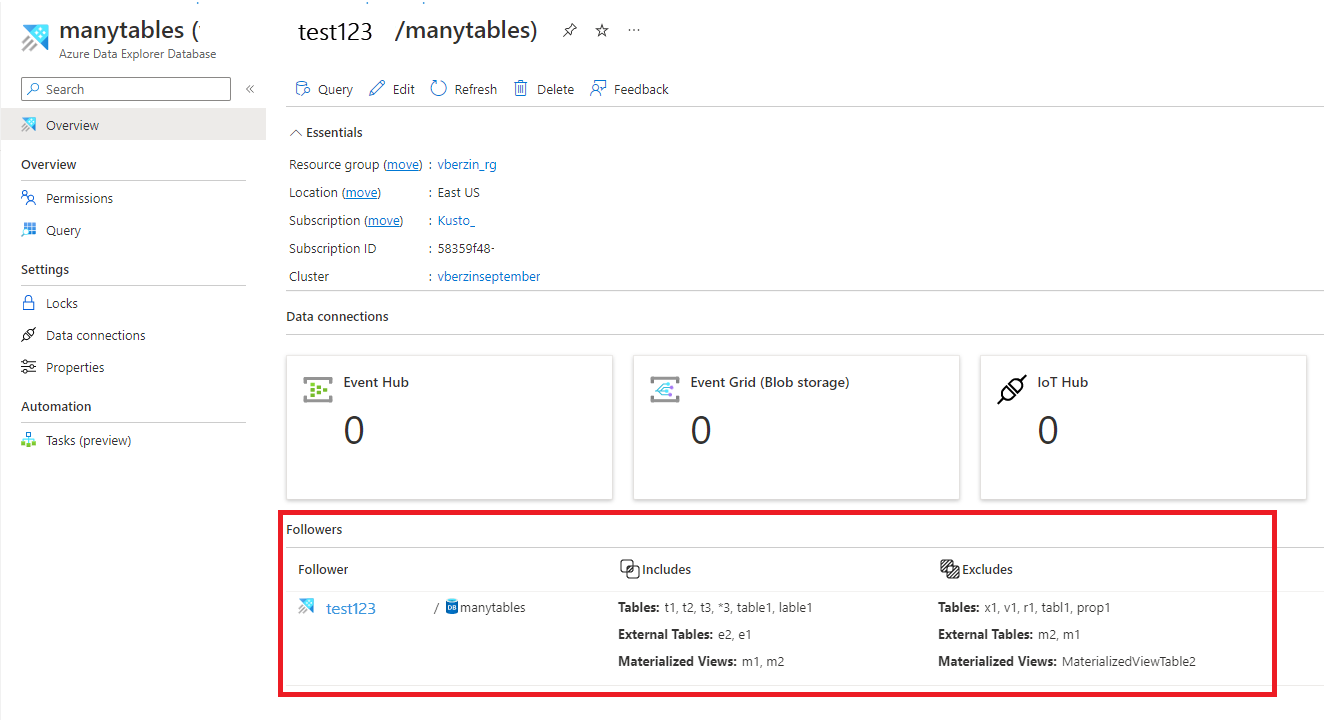팔로워 데이터베이스 기능을 사용하면 다른 클러스터에 있는 데이터베이스를 Azure Data Explorer 클러스터에 연결할 수 있습니다.
팔로워 데이터베이스는 읽기 전용 모드로 연결되므로 데이터를 볼 수 있고 리더 데이터베이스에 수집된 데이터에 대한 쿼리를 실행할 수 있습니다. 팔로워 데이터베이스는 리더 데이터베이스의 변경 내용을 동기화합니다. 동기화 때문에, 데이터 가용성에 몇 초에서 몇 분의 데이터 지연이 있습니다. 시간 지연의 길이는 리더 데이터베이스 메타데이터의 전체 크기에 따라 달라집니다. 리더 및 팔로워 데이터베이스는 동일한 스토리지 계정을 사용하여 데이터를 가져옵니다. 리더 데이터베이스는 스토리지를 소유합니다. 팔로워 데이터베이스는 데이터를 수집할 필요 없이 데이터를 볼 수 있습니다. 연결된 데이터베이스는 읽기 전용 데이터베이스이므로 데이터베이스의 데이터, 테이블 및 정책을 수정할 수 없으며 다만, 캐싱 정책, 보안 주체 및 권한은 제외됩니다. 연결된 데이터베이스는 삭제할 수 없습니다. 리더 또는 팔로워는 삭제하기 전에 데이터베이스를 분리해야 합니다.
팔로워 기능을 사용하여 다른 클러스터에 데이터베이스를 연결하는 것은 조직과 팀 간에 데이터를 공유하기 위한 인프라로 사용됩니다. 이 기능은 프로덕션 환경을 보호하기 위해 컴퓨팅 리소스를 비프로덕션 사용 사례와 분리하는 데 유용합니다. 팔로워는 Azure Data Explorer 클러스터의 비용을 데이터에 대한 쿼리를 실행하는 파티와 연결하는 데 사용할 수도 있습니다.
참고 항목
이전 SDK 버전을 기반으로 하는 코드 샘플은 보관된 문서를 참조하세요.
어떤 데이터베이스가 팔로우되나요?
클러스터에는 다음이 적용됩니다.
- 클러스터는 리더 클러스터의 데이터베이스 하나, 여러 데이터베이스 또는 모든 데이터베이스를 팔로우할 수 있습니다.
- 클러스터 하나가 여러 리더 클러스터의 데이터베이스를 팔로우할 수 있습니다.
- 클러스터는 팔로워 데이터베이스와 리더 데이터베이스를 모두 포함할 수 있습니다.
필수 구성 요소
데이터베이스 연결
데이터베이스를 연결하는 데 사용할 수 있는 방법은 다양합니다. 이 문서에서는 C#, Python, PowerShell 또는 Azure Resource Manager 템플릿을 사용하여 데이터베이스를 연결하는 방법에 대해 설명합니다.
데이터베이스를 연결하려면 리더 클러스터 및 팔로워 클러스터에 대한 기여자 역할 이상의 사용자, 그룹, 서비스 주체 또는 관리 ID가 있어야 합니다.
Azure Portal, PowerShell, Azure CLI, ARM 템플릿을 사용하여 역할 할당을 추가하거나 제거합니다.
Azure RBAC(Azure 역할 기반 액세스 제어) 및 다양한 역할에 대해 자세히 알아보세요.
참고 항목
첨부 파일 프로세스 중에 만들어지기 때문에 팔로워 데이터베이스를 미리 만들 필요는 없습니다.
테이블 수준 공유
데이터베이스를 연결할 때 모든 테이블, 외부 테이블 및 구체화된 뷰도 따릅니다. 특정 테이블/외부 테이블/구체화된 뷰는 'TableLevelSharingProperties'를 설정하여 공유할 수 있습니다.
'TableLevelSharingProperties'에는 8개의 문자열 tablesToInclude배열, 즉 , tablesToExclude, externalTablesToInclude, externalTablesToExcludematerializedViewsToInclude, materializedViewsToExcludefunctionsToInclude및 functionsToExclude. 모든 배열의 최대 항목 수는 합쳐서 100개입니다.
참고 항목
- 테이블 수준 공유는 '*' 모든 데이터베이스 표기법을 사용할 때 지원되지 않습니다.
- 구체화된 뷰가 포함되면 원본 테이블도 포함됩니다.
예제
다음 예제에는 모든 테이블이 포함됩니다. 기본적으로 '*' 표기법을 사용하지 않고 모든 테이블이 뒤따릅니다.
tablesToInclude = []
다음 예제에는 모든 함수가 포함됩니다. 기본적으로 모든 함수는 '*' 표기법을 사용하지 않고 따릅니다.
functionsToInclude = []
다음 예제에서는 이름이 "Logs"로 시작하는 모든 테이블을 포함합니다.
tablesToInclude = ["Logs*"]
다음 예제에는 모든 외부 테이블이 포함됩니다.
externalTablesToExclude = ["*"]
다음 예제에는 구체화된 모든 뷰가 포함됩니다.
materializedViewsToExclude=["*"]
데이터베이스 이름 재정의
선택적으로 팔로워 클러스터의 데이터베이스 이름을 리더 클러스터와 다르게 만들 수 있습니다. 예를 들어, 여러 리더 클러스터의 동일한 데이터베이스 이름을 팔로워 클러스터에 연결할 수 있습니다. 다른 데이터베이스 이름을 지정하려면 'DatabaseNameOverride' 또는 'DatabaseNamePrefix' 속성을 구성합니다.
C#을 사용하여 데이터베이스 연결
필요한 NuGet 패키지
C# 예제
var followerClusterId = KustoClusterResource.CreateResourceIdentifier(subscriptionId: "xxxxxxxx-xxxxx-xxxx-xxxx-xxxxxxxxx", resourceGroupName: "followerResourceGroup", clusterName: "follower");
var leaderClusterId = KustoClusterResource.CreateResourceIdentifier(subscriptionId: "xxxxxxxx-xxxxx-xxxx-xxxx-xxxxxxxxx", resourceGroupName: "leaderResourceGroup", clusterName: "leader");
var attachedDatabaseConfigurationName = "attachedDatabaseConfiguration";
var credentials = new ManagedIdentityCredential();
var resourceManagementClient = new ArmClient(credentials);
var followerCluster = resourceManagementClient.GetKustoClusterResource(followerClusterId);
var attachedDatabaseConfigurations = followerCluster.GetKustoAttachedDatabaseConfigurations();
var attachedDatabaseConfigurationData = new KustoAttachedDatabaseConfigurationData
{
ClusterResourceId = leaderClusterId,
DatabaseName = "<databaseName>", // Can be a specific database name in a leader cluster or * for all databases
DefaultPrincipalsModificationKind = KustoDatabaseDefaultPrincipalsModificationKind.Union,
Location = AzureLocation.NorthCentralUS
};
// Table level sharing properties are not supported when using '*' all databases notation.
if (attachedDatabaseConfigurationData.DatabaseName != "*")
{
// Set up the table level sharing properties - the following is just an example.
attachedDatabaseConfigurationData.TableLevelSharingProperties = new KustoDatabaseTableLevelSharingProperties();
attachedDatabaseConfigurationData.TableLevelSharingProperties.TablesToInclude.Add("table1");
attachedDatabaseConfigurationData.TableLevelSharingProperties.TablesToExclude.Add("table2");
attachedDatabaseConfigurationData.TableLevelSharingProperties.ExternalTablesToExclude.Add("exTable1");
attachedDatabaseConfigurationData.TableLevelSharingProperties.ExternalTablesToInclude.Add("exTable2");
attachedDatabaseConfigurationData.TableLevelSharingProperties.MaterializedViewsToInclude.Add("matTable1");
attachedDatabaseConfigurationData.TableLevelSharingProperties.MaterializedViewsToExclude.Add("matTable2");
attachedDatabaseConfigurationData.TableLevelSharingProperties.FunctionsToInclude.Add("func1");
attachedDatabaseConfigurationData.TableLevelSharingProperties.FunctionsToExclude.Add("func2");
}
await attachedDatabaseConfigurations.CreateOrUpdateAsync(WaitUntil.Completed, attachedDatabaseConfigurationName, attachedDatabaseConfigurationData);
Python을 사용하여 데이터베이스 연결
필수 구성 요소 모듈
pip install azure-identity
pip install azure-mgmt-kusto
Python 예제
from azure.mgmt.kusto import KustoManagementClient
from azure.mgmt.kusto.models import AttachedDatabaseConfiguration, TableLevelSharingProperties
from azure.identity import ClientSecretCredential
import datetime
#Directory (tenant) ID
tenant_id = "xxxxxxxx-xxxxx-xxxx-xxxx-xxxxxxxxx"
#Application ID
client_id = "xxxxxxxx-xxxxx-xxxx-xxxx-xxxxxxxxx"
#Client Secret
client_secret = "xxxxxxxxxxxxxx"
follower_subscription_id = "xxxxxxxx-xxxxx-xxxx-xxxx-xxxxxxxxx"
leader_subscription_id = "xxxxxxxx-xxxxx-xxxx-xxxx-xxxxxxxxx"
credentials = ClientSecretCredential(
tenant_id=tenant_id,
client_id=client_id,
client_secret=client_secret
)
kusto_management_client = KustoManagementClient(credentials, follower_subscription_id)
follower_resource_group_name = "followerResourceGroup"
leader_resource_group_name = "leaderResourceGroup"
follower_cluster_name = "follower"
leader_cluster_name = "leader"
attached_database_Configuration_name = "uniqueNameForAttachedDatabaseConfiguration"
database_name = "db" # Can be a specific database name in a leader cluster or * for all databases
default_principals_modification_kind = "Union"
location = "North Central US"
cluster_resource_id = "/subscriptions/" + leader_subscription_id + "/resourceGroups/" + leader_resource_group_name + "/providers/Microsoft.Kusto/Clusters/" + leader_cluster_name
table_level_sharing_properties = None
if (database_name != "*"):
#Set up the table level sharing properties - the following is just an example.
tables_to_include = ["table1", "table2", "table3"]
external_tables_to_exclude = ["Logs*"]
table_level_sharing_properties = TableLevelSharingProperties(tables_to_include = tables_to_include, external_tables_to_exclude = external_tables_to_exclude)
attached_database_configuration_properties = AttachedDatabaseConfiguration(cluster_resource_id = cluster_resource_id, database_name = database_name, default_principals_modification_kind = default_principals_modification_kind, location = location, table_level_sharing_properties = table_level_sharing_properties)
#Returns an instance of LROPoller, see https://learn.microsoft.com/python/api/msrest/msrest.polling.lropoller?view=azure-python
poller = kusto_management_client.attached_database_configurations.begin_create_or_update(follower_resource_group_name, follower_cluster_name, attached_database_Configuration_name, attached_database_configuration_properties)
PowerShell을 사용하여 데이터베이스 연결
필수 구성 요소 모듈
Install : Az.Kusto
PowerShell 예제
$FollowerClustername = 'follower'
$FollowerClusterSubscriptionID = 'xxxxxxxx-xxxxx-xxxx-xxxx-xxxxxxxxx'
$FollowerResourceGroupName = 'followerResourceGroup'
$DatabaseName = "db" ## Can be a specific database name in a leader cluster or * for all databases
$FollowerDatabaseName = 'followerdbname' ## Use this option if the follower database requires a different name than the leader database.
$LeaderClustername = 'leader'
$LeaderClusterSubscriptionID = 'xxxxxxxx-xxxxx-xxxx-xxxx-xxxxxxxxx'
$LeaderClusterResourceGroup = 'leaderResourceGroup'
$DefaultPrincipalsModificationKind = 'Union'
##Construct the LeaderClusterResourceId and Location
$getleadercluster = Get-AzKustoCluster -Name $LeaderClustername -ResourceGroupName $LeaderClusterResourceGroup -SubscriptionId $LeaderClusterSubscriptionID -ErrorAction Stop
$LeaderClusterResourceid = $getleadercluster.Id
$Location = $getleadercluster.Location
## Handle the config name if all databases need to be followed. The config name can be given any unique name
if($DatabaseName -eq '*') {
$configname = $FollowerClustername + 'config'
}
else {
$configname = $DatabaseName
}
##Table level sharing is not supported when using '*' all databases notation. If you use the all database notation please remove all table level sharing lines from the powershell command.
New-AzKustoAttachedDatabaseConfiguration -ClusterName $FollowerClustername `
-Name $configname `
-ResourceGroupName $FollowerResourceGroupName `
-SubscriptionId $FollowerClusterSubscriptionID `
-DatabaseName $DatabaseName ` ## Leader database name.
-DatabaseNameOverride $FollowerDatabaseName ` ## Use this option if the follower database requires a different name than the leader database. Otherwise, this parameter can be removed.
-ClusterResourceId $LeaderClusterResourceid `
-DefaultPrincipalsModificationKind $DefaultPrincipalsModificationKind `
-Location $Location `
-TableLevelSharingPropertyTablesToInclude "table1", "table2", "table3" `
-TableLevelSharingPropertyExternalTablesToExclude "Logs*" `
-ErrorAction Stop
Azure Resource Manager 템플릿을 사용하여 데이터베이스 연결
Azure Resource Manager 템플릿을 사용하여 기존 클러스터에 데이터베이스를 연결할 수 있습니다.
다음 단계에 따라 데이터베이스를 연결합니다.
다음 표의 정보를 사용하여 템플릿을 만들면 쉽게 구성할 수 있습니다.
|
매개 변수 |
설명 |
예제 |
|
followerClusterName |
팔로워 클러스터의 이름입니다. 템플릿이 배포되는 위치입니다. |
|
|
연결된데이터베이스구성설정이름 |
연결된 데이터베이스 구성 개체의 이름입니다. 이 이름은 클러스터 수준에서 고유한 문자열이면 됩니다. |
|
|
databaseName |
팔로우할 데이터베이스의 이름입니다. 모든 리더의 데이터베이스를 팔로우하려면 '*'를 사용합니다. |
|
|
leaderClusterResourceId |
리더 클러스터의 리소스 ID입니다. |
|
|
기본 프린시플 수정 유형 |
기본 보안 주체 수정 종류입니다. |
Union, Replace 또는 None일 수 있습니다. 기본 보안 주체 수정 종류에 대한 자세한 내용은 보안 주체 수정 종류 관리 명령을 참조 하세요. |
|
포함할_테이블 |
포함할 테이블 목록입니다. 'Logs'로 시작하는 테이블을 모두 포함하려면, ["Logs*"]를 사용합니다. |
["table1ToInclude", "table2ToInclude"] |
|
제외할_테이블 |
제외할 테이블 목록입니다. 모든 테이블을 제외하려면 ["*"]를 사용합니다. |
["table1ToExclude", "table2ToExclude"] |
|
포함할 외부 테이블 |
포함할 테이블 목록입니다. 'Logs'로 시작하는 외부 테이블을 모두 포함하려면, ["Logs*"]를 사용합니다. |
["ExternalTable1ToInclude", "ExternalTable2ToInclude"] |
|
externalTablesToExclude |
제외할 테이블 목록입니다. 모든 외부 테이블을 제외하려면 ["*"]를 사용합니다. |
["ExternalTable1ToExclude", "ExternalTable2ToExclude"] |
|
포함할 구체화된 뷰 |
포함할 구체화된 뷰 목록입니다. 'Logs'로 시작하는 구체화된 뷰를 모두 포함하려면 ["Logs*"]를 사용합니다. |
["Mv1ToInclude", "Mv2ToInclude"] |
|
제외할 구체화된 뷰들 |
제외할 구체화된 뷰 목록입니다. 구체화된 뷰를 모두 제외하려면 ["*"]를 사용합니다. |
["Mv11ToExclude", "Mv22ToExclude"] |
|
포함할 함수 |
포함할 함수 목록입니다. |
["FunctionToInclude"] |
|
제외할_함수 |
제외할 함수 목록입니다. |
["FunctionToExclude"] |
|
위치 |
모든 리소스의 위치입니다. 리더와 팔로워는 같은 위치에 있어야 합니다. |
|
{
"$schema": "https://schema.management.azure.com/schemas/2015-01-01/deploymentTemplate.json#",
"contentVersion": "1.0.0.0",
"parameters": {
"followerClusterName": {
"type": "string",
"defaultValue": "",
"metadata": {
"description": "Name of the cluster to which the database will be attached."
}
},
"attachedDatabaseConfigurationsName": {
"type": "string",
"defaultValue": "",
"metadata": {
"description": "Name of the attached database configurations to create."
}
},
"databaseName": {
"type": "string",
"defaultValue": "",
"metadata": {
"description": "The name of the database to follow. You can follow all databases by using '*'."
}
},
"leaderClusterResourceId": {
"type": "string",
"defaultValue": "",
"metadata": {
"description": "The resource ID of the leader cluster."
}
},
"defaultPrincipalsModificationKind": {
"type": "string",
"defaultValue": "Union",
"metadata": {
"description": "The default principal modification kind."
}
},
"tablesToInclude": {
"type": "array",
"defaultValue": [],
"metadata": {
"description": "The list of tables to include. Not supported when following all databases."
}
},
"tablesToExclude": {
"type": "array",
"defaultValue": [],
"metadata": {
"description": "The list of tables to exclude. Not supported when following all databases."
}
},
"externalTablesToInclude": {
"type": "array",
"defaultValue": [],
"metadata": {
"description": "The list of external tables to include. Not supported when following all databases."
}
},
"externalTablesToExclude": {
"type": "array",
"defaultValue": [],
"metadata": {
"description": "The list of external tables to exclude. Not supported when following all databases."
}
},
"materializedViewsToInclude": {
"type": "array",
"defaultValue": [],
"metadata": {
"description": "The list of materialized views to include. Not supported when following all databases."
}
},
"materializedViewsToExclude": {
"type": "array",
"defaultValue": [],
"metadata": {
"description": "The list of materialized views to exclude. Not supported when following all databases."
}
},
"functionsToInclude": {
"type": "array",
"defaultValue": [],
"metadata": {
"description": "The list of functions to include."
}
},
"functionsToExclude": {
"type": "array",
"defaultValue": [],
"metadata": {
"description": "The list of functions to exclude."
}
},
"location": {
"type": "string",
"defaultValue": "",
"metadata": {
"description": "Location for all resources."
}
}
},
"variables": {},
"resources": [
{
"name": "[concat(parameters('followerClusterName'), '/', parameters('attachedDatabaseConfigurationsName'))]",
"type": "Microsoft.Kusto/clusters/attachedDatabaseConfigurations",
"apiVersion": "2021-01-01",
"location": "[parameters('location')]",
"properties": {
"databaseName": "[parameters('databaseName')]",
"clusterResourceId": "[parameters('leaderClusterResourceId')]",
"defaultPrincipalsModificationKind": "[parameters('defaultPrincipalsModificationKind')]",
"tableLevelSharingProperties":{
"tablesToInclude": "[parameters('tablesToInclude')]",
"tablesToExclude": "[parameters('tablesToExclude')]",
"externalTablesToInclude": "[parameters('externalTablesToInclude')]",
"externalTablesToExclude": "[parameters('externalTablesToExclude')]",
"materializedViewsToInclude": "[parameters('materializedViewsToInclude')]",
"materializedViewsToExclude": "[parameters('materializedViewsToExclude')]",
"functionsToInclude": "[parameters('functionsToInclude')]",
"functionsToExclude": "[parameters('functionsToExclude')]"
}
}
}
]
}
Azure Portal 또는 PowerShell을 사용하여 Azure Resource Manager 템플릿을 배포합니다.

데이터베이스가 연결되었는지 확인
데이터베이스가 성공적으로 연결되었는지 확인하려면 Azure Portal에서 연결된 데이터베이스를 찾습니다.
팔로워 또는 리더 클러스터에서 데이터베이스가 성공적으로 연결되었는지 확인할 수 있습니다.
팔로워 클러스터 확인
팔로워 클러스터를 찾아 데이터베이스를 선택합니다.
데이터베이스 목록에서 새 읽기 전용 데이터베이스를 검색합니다.

데이터베이스 개요 페이지에서 이 목록을 볼 수도 있습니다.

리더 클러스터 확인
리더 클러스터를 찾아 데이터베이스를 선택합니다.
관련 데이터베이스가 다른 사용자와 공유됨>예로 표시되어 있는지 확인합니다.
세부 정보를 보려면 관계 링크를 전환합니다.

데이터베이스 개요 페이지에서도 이를 볼 수 있습니다.

팔로워 데이터베이스 분리
참고 항목
팔로워 또는 리더 쪽에서 데이터베이스를 분리하려면 데이터베이스를 분리하는 클러스터에서 적어도 기여자 역할이 있는 사용자, 그룹, 서비스 주체 또는 관리 ID가 있어야 합니다. 아래 예제에서는 서비스 주체를 사용합니다.
C#을 사용하여 팔로워 클러스터에서 연결된 팔로워 데이터베이스 분리**
팔로워 클러스터는 연결된 팔로워 데이터베이스를 다음과 같이 분리할 수 있습니다.
var attachedDatabaseConfigurationId = KustoAttachedDatabaseConfigurationResource.CreateResourceIdentifier(
subscriptionId: "xxxxxxxx-xxxxx-xxxx-xxxx-xxxxxxxxx", resourceGroupName: "testrg", clusterName: "follower",
attachedDatabaseConfigurationName: "attachedDatabaseConfiguration");
var credentials = new ManagedIdentityCredential();
var resourceManagementClient = new ArmClient(credentials);
var attachedDatabaseConfiguration = resourceManagementClient.GetKustoAttachedDatabaseConfigurationResource(attachedDatabaseConfigurationId);
await attachedDatabaseConfiguration.DeleteAsync(WaitUntil.Completed);
C#을 사용하여 리더 클러스터에서 연결된 팔로워 데이터베이스 분리
리더 클러스터는 연결된 데이터베이스를 다음과 같이 분리할 수 있습니다.
var leaderClusterId = KustoClusterResource.CreateResourceIdentifier(subscriptionId: "xxxxxxxx-xxxxx-xxxx-xxxx-xxxxxxxxx", resourceGroupName: "testrg", clusterName: "leader");
var followerClusterId = KustoClusterResource.CreateResourceIdentifier(subscriptionId: "xxxxxxxx-xxxxx-xxxx-xxxx-xxxxxxxxx", resourceGroupName: "followerResourceGroup", clusterName: "follower");
var followerDatabaseDefinition = new KustoFollowerDatabaseDefinition(
clusterResourceId: followerClusterId,
attachedDatabaseConfigurationName: "attachedDatabaseConfiguration"
);
var credentials = new ManagedIdentityCredential();
var resourceManagementClient = new ArmClient(credentials);
var leaderCluster = resourceManagementClient.GetKustoClusterResource(leaderClusterId);
await leaderCluster.DetachFollowerDatabasesAsync(WaitUntil.Completed, followerDatabaseDefinition);
Python을 사용하여 팔로워 클러스터에서 연결된 팔로워 데이터베이스 분리
팔로워 클러스터는 연결된 데이터베이스를 다음과 같이 분리할 수 있습니다.
from azure.mgmt.kusto import KustoManagementClient
from azure.common.credentials import ServicePrincipalCredentials
import datetime
#Directory (tenant) ID
tenant_id = "xxxxxxxx-xxxxx-xxxx-xxxx-xxxxxxxxx"
#Application ID
client_id = "xxxxxxxx-xxxxx-xxxx-xxxx-xxxxxxxxx"
#Client Secret
client_secret = "xxxxxxxxxxxxxx"
follower_subscription_id = "xxxxxxxx-xxxxx-xxxx-xxxx-xxxxxxxxx"
credentials = ServicePrincipalCredentials(
client_id=client_id,
secret=client_secret,
tenant=tenant_id
)
kusto_management_client = KustoManagementClient(credentials, follower_subscription_id)
follower_resource_group_name = "followerResourceGroup"
follower_cluster_name = "follower"
attached_database_configurationName = "uniqueName"
#Returns an instance of LROPoller, see https://learn.microsoft.com/python/api/msrest/msrest.polling.lropoller?view=azure-python
poller = kusto_management_client.attached_database_configurations.delete(follower_resource_group_name, follower_cluster_name, attached_database_configurationName)
Python을 사용하여 리더 클러스터에서 연결된 팔로워 데이터베이스 분리
리더 클러스터는 연결된 데이터베이스를 다음과 같이 분리할 수 있습니다.
from azure.mgmt.kusto import KustoManagementClient
from azure.mgmt.kusto.models import FollowerDatabaseDefinition
from azure.common.credentials import ServicePrincipalCredentials
import datetime
#Directory (tenant) ID
tenant_id = "xxxxxxxx-xxxxx-xxxx-xxxx-xxxxxxxxx"
#Application ID
client_id = "xxxxxxxx-xxxxx-xxxx-xxxx-xxxxxxxxx"
#Client Secret
client_secret = "xxxxxxxxxxxxxx"
follower_subscription_id = "xxxxxxxx-xxxxx-xxxx-xxxx-xxxxxxxxx"
leader_subscription_id = "xxxxxxxx-xxxxx-xxxx-xxxx-xxxxxxxxx"
credentials = ServicePrincipalCredentials(
client_id=client_id,
secret=client_secret,
tenant=tenant_id
)
kusto_management_client = KustoManagementClient(credentials, follower_subscription_id)
follower_resource_group_name = "followerResourceGroup"
leader_resource_group_name = "leaderResourceGroup"
follower_cluster_name = "follower"
leader_cluster_name = "leader"
attached_database_configuration_name = "uniqueName"
location = "North Central US"
cluster_resource_id = "/subscriptions/" + follower_subscription_id + "/resourceGroups/" + follower_resource_group_name + "/providers/Microsoft.Kusto/Clusters/" + follower_cluster_name
#Returns an instance of LROPoller, see https://learn.microsoft.com/python/api/msrest/msrest.polling.lropoller?view=azure-python
poller = kusto_management_client.clusters.detach_follower_databases(resource_group_name = leader_resource_group_name, cluster_name = leader_cluster_name, cluster_resource_id = cluster_resource_id, attached_database_configuration_name = attached_database_configuration_name)
PowerShell을 사용하여 데이터베이스 분리
필수 구성 요소 모듈
Install : Az.Kusto
예제
$FollowerClustername = 'follower'
$FollowerClusterSubscriptionID = 'xxxxxxxx-xxxxx-xxxx-xxxx-xxxxxxxxx'
$FollowerResourceGroupName = 'followerResourceGroup'
$DatabaseName = "sanjn" ## Can be specific database name or * for all databases
##Construct the Configuration name
$confignameraw = (Get-AzKustoAttachedDatabaseConfiguration -ClusterName $FollowerClustername -ResourceGroupName $FollowerResourceGroupName -SubscriptionId $FollowerClusterSubscriptionID) | Where-Object {$_.DatabaseName -eq $DatabaseName }
$configname =$confignameraw.Name.Split("/")[1]
Remove-AzKustoAttachedDatabaseConfiguration -ClusterName $FollowerClustername -Name $configname -ResourceGroupName $FollowerResourceGroupName -SubscriptionId $FollowerClusterSubscriptionID
보안 주체, 권한 및 캐싱 정책 관리
보안 주체 관리
데이터베이스를 연결할 때 "기본 보안 주체 수정 종류"를 지정합니다. 기본값은 권한 있는 보안 주체 재정의와 권한 있는 보안 주체의 리더 데이터베이스 컬렉션을 결합하는 것입니다.
|
종류 |
설명 |
|
연합 |
연결된 데이터베이스 보안 주체에 원본 데이터베이스 보안 주체와 팔로워 데이터베이스에 추가된 다른 새 보안 주체가 항상 포함됩니다. |
|
바꾸기 |
원본 데이터베이스의 보안 주체를 상속하지 않습니다. 연결된 데이터베이스에 대해 새 보안 주체를 만들어야 합니다. |
|
없음 |
연결된 데이터베이스 보안 주체에는 원래 데이터베이스의 보안 주체만 포함되고 다른 보안 주체는 포함되지 않습니다. |
관리 명령을 사용하여 권한 있는 보안 주체를 구성하는 방법에 대한 자세한 내용은 팔로워 클러스터를 관리하기 위한 관리 명령을 참조하세요.
사용 권한 관리
읽기 전용 데이터베이스 권한을 관리하는 것은 모든 데이터베이스 유형의 경우와 동일합니다. 권한을 할당하려면 Azure Portal에서 데이터베이스 권한 관리를 참조하거나 관리 명령을 사용하여 데이터베이스 보안 역할을 관리합니다.
팔로워 데이터베이스 관리자는 호스팅 클러스터에 있는 연결된 데이터베이스 또는 테이블의 캐싱 정책을 수정할 수 있습니다. 기본값은 리더 클러스터 데이터베이스의 원본 데이터베이스와 테이블 수준 캐싱 정책을 데이터베이스 및 테이블 수준 재정의 정책에 정의된 정책과 결합하는 것입니다. 예를 들어, 리더 데이터베이스에는 월간 보고를 실행하기 위한 30일 캐싱 정책을 설정하고 팔로워 데이터베이스에는 문제 해결을 위해 최근 데이터만 쿼리하도록 3일 캐싱 정책을 설정할 수 있습니다. 관리 명령을 사용하여 팔로워 데이터베이스 또는 테이블에서 캐싱 정책을 구성하는 방법에 대한 자세한 내용은 팔로워 클러스터를 관리하기 위한 관리 명령을 참조하세요.
주의
다음 참고 사항을 검토합니다.
- 리더/팔로워 클러스터의 데이터베이스 간에 충돌이 있는 경우 모든 데이터베이스 다음에 팔로워 클러스터가 오면 다음과 같이 해결됩니다.
- 팔로워 클러스터에서 생성된 DB라는 이름의 데이터베이스는 리더 클러스터에서 생성된 동일한 이름의 데이터베이스보다 우선합니다. 따라서 팔로워 클러스터에 있는 데이터베이스인 DB를 제거하거나 이름을 바꿔야 팔로워 클러스터가 리더의 데이터베이스인 DB를 포함할 수 있습니다.
- 둘 이상의 리더 클러스터에서 팔로우되는 DB라는 데이터베이스는 리더 클러스터 중 하나에서 임의로 선택되며 두 번 이상 팔로우되지 않습니다.
- 팔로워 클러스터에서 실행되는 클러스터 활동 로그 및 기록을 표시하는 명령은 팔로워 클러스터의 활동 및 기록을 표시하며, 결과 집합에는 리더 클러스터 또는 클러스터의 결과가 포함되지 않습니다.
- 예를 들어, 팔로워 클러스터에서 실행되는
.show queries 명령은 팔로워 클러스터가 따르는 데이터베이스에서 수행된 쿼리만을 표시하며, 리더 클러스터의 동일한 데이터베이스에 대해 수행된 쿼리는 표시하지 않습니다.
제한 사항
다음 제한 사항을 검토합니다.
- 팔로워와 리더 클러스터는 동일한 지역에 있어야 합니다.
- 팔로우하는 데이터베이스에서 스트리밍 수집을 사용하는 경우 스트리밍 수집 데이터의 팔로우를 허용하도록 스트리밍 수집에 대해 팔로워 클러스터를 사용하도록 설정해야 합니다.
- CMK(고객 관리형 키)를 사용하여 데이터 암호화를 사용하는 클러스터에 따라 다음과 같은 제한 사항이 지원됩니다.
- 팔로워 클러스터 또는 리더 클러스터는 다른 클러스터를 따르지 않습니다.
- 팔로워 클러스터가 CMK를 사용하도록 설정된 리더 클러스터를 따르고 키에 대한 리더의 액세스가 취소되면 리더와 팔로워 클러스터가 모두 일시 중단됩니다. 이 경우 CMK 문제를 해결한 다음 팔로워 클러스터를 다시 시작하거나 팔로워 클러스터에서 팔로워 데이터베이스를 분리하고 리더 클러스터와 독립적으로 다시 시작할 수 있습니다.
- 다른 클러스터에 연결된 데이터베이스는 연결을 분리하기 전에는 삭제할 수 없습니다.
- 다른 클러스터에 연결된 데이터베이스가 있는 클러스터는 연결을 분리하기 전에는 삭제할 수 없습니다.
- 테이블 수준 공유 속성은 모든 데이터베이스를 팔로우할 때 지원되지 않습니다.
- 팔로워 데이터베이스에서 관리 ID를 인증 방법으로 사용하는 외부 테이블을 쿼리하려면 관리 ID를 팔로워 클러스터에 추가해야 합니다. 이 기능은 리더 및 팔로워 클러스터가 다른 테넌트에 프로비전될 때 작동하지 않습니다.
다음 단계




